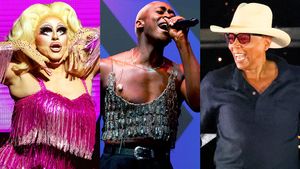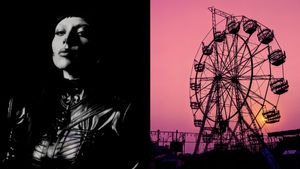Born in Hong Kong and raised there, Texas and rural England Andrew Printer is a British photographer and video artist who has been living and working in southern California since 1991.
Printer's videos have been screened widely at festivals in Europe, the U.S., and on public television. His photographs have been exhibited in solo and group exhibitions worldwide, are included in several private collections, and are part of the permanent collection of the Museum of Fine Arts, Houston and the Library of the University of Indiana, Bloomington. He is also the recipient of several grants and scholarships.
Printer obtained his M.F.A. at the University of California, Irvine where his practice evolved into something more interdisciplinary, encompassing and incorporating photography, painting, performance and text.
How did you come to be a photographer (and also a painter)?I was originally interested in film and video and made two documentaries in the early 1990s. They both played widely on the LGBT film and video circuit. Ten years later, after a career in non-profits, I returned to art but chose not to return to video, which was still relatively expensive and cumbersome. I took a photography class, and one thing led to another until I began my MFA. At grad school I realized that I was interested in whatever medium made sense to me. Now I use photography, text, performance, and painting. My first short story was just published in
The Frozen Moment, an anthology of contemporary writers.
The images from Normal Heights are so pop and colorful. Can you tell us more about these images and about your model selection, locations, etc.?"Second Thoughts" from
Normal Heights is a series of photographs that lifts the convoluted gestures, poses, and tactics employed by homosexual photographers of the twentieth century in the name of desire and drops them into a variety of domestic spaces in Normal Heights, an urban neighborhood in San Diego that has become home to a sizable gay population.
In the mid-1950s and earlier, a variety of strategies were employed to circumvent censure and legitimately make, look at, and circulate images of one naked man alongside another...or several others. An example is Bob Mizer, who recognized the longings of ordinary men, both health-oriented and homosexually-oriented, in post-war, small-town America.
Many of these once plausible configurations look profoundly peculiar to me. I am struck by the contrivance of the strategies and drawn to what Thomas Waugh describes as the "awkward looks of the models...that amplifies the usual feeling of self-consciousness and unease."
Equally peculiar to me is the recent drift of the broader LGBT community toward "respectability" as it aims to assimilate into hetero-normative structures at the expense of its own history as well as its more "radical" fringe. For me, there is something inauthentic and awkward at the root of this drive. Desire has gone. Domesticity reigns. Alternative possibilities are long forgotten.
Most of my photography is representational, and I am less interested in the classic -- young, ripped, white -- subject and more interested in people I experience in my life. I find most of my models online and know them only for a day. A lot of my work contains color, humor, and narrative. I think this stems from my early appreciation of cinema and a reaction to the gravity and grief of the early AIDS years.
The images from Last Seen seem to have a more complex narrative. Can you tell us more about them and what holds them together as a set for you?I incorporated old and found images in my MFA thesis exhibition. I suppose my project was about histories/memories lost in the archive, including my own sizable collection of old photos.
The
Last Seen series consists of photographs of people I knew well -- from a memorable one night stand to my first long term relationship -- and photographed back when I would have called myself an "amateur" photographer. The images in this series are specifically those photographs that I would have left out of my photo album because of a technical error. What was once a problem -- closed eyes, incorrect color cast, under-exposure, backlighting -- is now something beautiful to me. Each image also represents the last -- sometimes also the first -- time I saw the person in the photo. Since some of these images date back to the 1980s, so it is likely they died of AIDS, but I don't know.
What artists, writers, etc., are you inspired by, and do you feel they have an influence on your work?I always stumble over this question. I can say that I am surely influenced by certain aspects of television, advertising, and cinema. My early work was deliberately documentary-oriented, and I have always appreciated Britain's history in this area. At the moment I am focused on my writing so Tom Spanbauer and Christopher Coe are coming to mind as immediate influences.
I expect I mimic certain artists' work without knowing it, and like any gay artist I am sure my approach can be traced back to the emphatic AIDS/ACT UP years. I am inclined to say that I am not very clever or deliberate about anything. Everything just seems weird to me, from the way people behave, to the way two words sit next to each other, to this color and that. I just follow a thought now and then and let it all sift together.


















































































Fans thirsting over Chris Colfer's sexy new muscles for Coachella